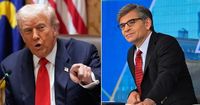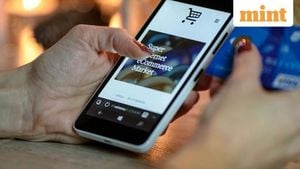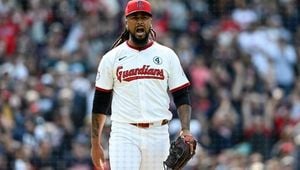On a brisk Tuesday at the White House, President Donald Trump refused to answer questions from an ABC News reporter, drawing a sharp line in the sand against the network he’s long accused of bias. The incident, which unfolded during a high-profile meeting with Argentine President Javier Milei, was the latest flashpoint in Trump’s ongoing feud with the media—one that’s only intensified since a contentious interview between ABC’s George Stephanopoulos and Vice President JD Vance just days earlier.
The drama began on October 12, 2025, when Stephanopoulos grilled Vance on national television about a $50,000 cash bribe that the FBI had caught Tom Homan, the White House border czar, accepting during a sting operation in September 2024. According to multiple outlets, including Raw Story and The Daily Beast, the FBI sting involved undercover agents posing as business executives who handed Homan the cash, allegedly in exchange for promises to arrange government contracts related to border security once Trump returned to office.
Despite the damning evidence—an audio recording of the exchange—no charges were ever brought against Homan. The Department of Justice closed its investigation just last month, and Homan has consistently denied any wrongdoing. The Trump administration, which dropped the probe after taking office, has stood firmly behind him throughout the ordeal. But the question that continues to dog the administration is simple: What happened to the $50,000?
Stephanopoulos pressed Vance repeatedly. “Tom Homan did not take a bribe,” Vance insisted during the interview, as reported by The Daily Beast. “It’s a ridiculous smear. And the reason you guys are going after Tom Homan so aggressively is because he’s doing the job of enforcing the law. I think it’s really preposterous.”
But Stephanopoulos wasn’t satisfied. “But, wait, you said he didn’t take a bribe,” he countered. “But I’m not sure you answered the question. Are you saying that he did not accept the $50,000?”
Vance, for his part, doubled down on his evasiveness. “George, I don’t know what you’re talking about. Did he accept $50,000 for what?” he replied, even as Stephanopoulos reminded him of the FBI surveillance tape. “Accepting $50,000 for doing what, George?” Vance shot back. “I am not even sure I understand the question. Is it illegal to take a payment for doing services? The FBI has not prosecuted him. I have never seen any evidence that he’s engaged in criminal wrongdoing. Nobody has accused Tom of violating a crime, even the far-left media like yourself.”
As the exchange grew more heated, Vance’s answers became increasingly circuitous. “So I’m actually not sure what the precise question is. Did he accept $50,000? Honestly, George, I don’t know the answer to that question. What I do know is that he didn’t violate a crime.”
The back-and-forth, which quickly devolved into a stalemate, ended with Stephanopoulos cutting to a commercial break—an abrupt conclusion that clearly ruffled feathers at the White House. Vance, visibly frustrated, lashed out at the anchor. “Here’s George why fewer and fewer people watch your program and why you’re losing credibility because you’re talking for now, five minutes with the Vice President of United States about this story regarding Tom Homan, a story that I’ve read about, but I don’t even know the video that you’re talking about,” he said, according to Raw Story. “I think the American people would benefit much more from [talking about the government shutdown] than from you going down some weird left-wing rabbit hole where the facts clearly show that Tom Homan didn’t engage in any criminal wrongdoing.”
By the time President Trump sat down with President Milei on October 14, the wounds were still fresh. As an ABC reporter attempted to ask a question, Trump cut him off with a characteristic flourish. “You’re ABC fake news, I don’t take questions from ABC fake news,” Trump declared, as reported by The Daily Beast. “After what you did with Stephanopoulos to the vice president of the United States—I don’t take questions from ABC fake news.”
Trump didn’t stop there. He referenced a recent $16 million lawsuit settlement with ABC News, a legal battle that had simmered earlier in 2025 over comments made by Stephanopoulos. “He was nice enough to pay me $16 million last time we came—he had to pay $16 million to me. Which is good. It was worth it. It was worth having somebody lie. You get $16 million. That’s good,” Trump quipped, according to Raw Story. “But JD had a very nasty person interviewing him and we can’t let that happen. It’s just inappropriate to cut off a highly respected vice president of the United States, mid-sentence. I guess it’s one way to win an argument. That was the only way. Certainly, it’s a pretty inappropriate.”
The president’s refusal to engage with ABC News was just the latest salvo in his ongoing campaign against what he calls “fake news.” Trump has a long history of targeting media figures he deems hostile, from daytime talk show hosts to late-night comedians. Recently, he’s taken shots at The View and its former staffer Alyssa Farah Griffin, as well as late-night host Stephen Colbert, whose show is set to end soon. Trump’s message is clear: he’s not afraid to go toe-to-toe with the press, especially when he feels his administration is under unfair scrutiny.
Meanwhile, the controversy surrounding Tom Homan and the $50,000 bribe remains unresolved in the public eye. The Department of Justice’s decision to close the investigation hasn’t quelled suspicions, particularly among critics who see the administration’s actions as a cover-up. Supporters, on the other hand, echo Vance’s assertion that the whole episode is a “bogus story” manufactured by left-leaning media outlets to undermine Trump’s efforts at the border.
The episode also highlights the increasingly fraught relationship between the White House and the press. While some argue that Stephanopoulos was simply doing his job by holding Vance accountable, others—especially within Trump’s orbit—see the interview as evidence of a broader media agenda. The fact that Trump used the incident as justification to shut out ABC News underscores the depth of his grievances.
As for the broader political implications, the standoff comes at a time of heightened tension in Washington. The U.S. Treasury’s $20 billion currency deal with Argentina, the ongoing government shutdown, and the ever-present specter of scandal have created a combustible atmosphere. In this environment, every interaction between the administration and the media takes on added significance, with both sides digging in their heels.
With the 2026 midterm elections on the horizon, the stakes are only getting higher. For Trump and his supporters, standing up to the press is a badge of honor—a sign that they won’t back down in the face of what they see as relentless opposition. For critics, however, the refusal to answer tough questions is a troubling sign for transparency and accountability in government.
In the end, the clash between Trump, Vance, and Stephanopoulos is more than just a media spat—it’s a window into the ongoing battle over truth, power, and the role of the press in American democracy. As the dust settles, one thing is certain: neither side is backing down anytime soon.




